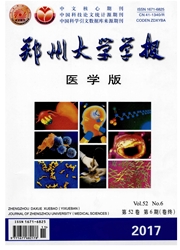

 中文摘要:
中文摘要:
目的:探讨外周血基因组DNA端粒长度与肺癌危险性的关系。方法:采用荧光定量PCR法检测200例肺癌患者(肺癌组)、200例健康体检者(对照组)外周血基因组DNA的相对端粒长度(RTL)。结果:肺癌组RTL小于对照组(P〈0.05)。按对照组RTL的中位数0.95为分界点,经非条件logistic回归分析,在调整年龄、吸烟状态后,RTL≤0.95显著增加患肺癌的危险性(OR=3.264,95%CI=2.134~4.992)。不同组织学类型和不同临床分期肺癌患者的RTL差异均无统计学意义(F=0.797,0.503,P均〉0.05)。结论:外周血基因组DNA端粒缩短可增加患肺癌的危险性,可能是肺癌发生发展过程中的早期效应生物学标志。
 英文摘要:
英文摘要:
Aim: To observe the association of peripheral blood genomic DNA telomere length with lung cancer. Methods: Quantitative PCR was used to detect the peripheral blood genomic DNA relative telomere length( RTL) of 200 lung cancer patients ( cancer group) and 200 healthy controls ( control group) . Results: RTL of the cancer group was low-er than that of the control group( P 0. 05) . When the subjects were categorized into 2 layers based on the median of RTL of the control group,the result of logistic regression showed that RTL≤0. 95 would be a risk factor for lung cancer( OR = 3. 264,95% CI = 2. 134 ~ 4. 992) when adjusting age and smoking status. There were no significant differences in RTL a-mong patients with different histological types or different stages( F = 0. 797,0. 503,P 0. 05) . Conclusion: The shorter telomere could increase the risk of lung cancer,and the detection of telomere length of peripheral blood genomic DNA could contribute to early diagnosis of lung cancer.
 同期刊论文项目
同期刊论文项目
 同项目期刊论文
同项目期刊论文
 期刊信息
期刊信息
